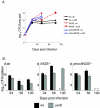Role for nucleotide excision repair in virulence of Mycobacterium tuberculosis
- PMID: 16040969
- PMCID: PMC1201236
- DOI: 10.1128/IAI.73.8.4581-4587.2005
Role for nucleotide excision repair in virulence of Mycobacterium tuberculosis
Abstract
Mutations in Mycobacterium tuberculosis uvrB result in severe sensitivity to acidified nitrite, a source of nitric oxide (6). In this study, we show that a uvrB mutant is exquisitely sensitive to UV light but not to several sources of reactive oxygen species in vitro. Furthermore, a uvrB mutant was attenuated in mice as judged by an extension of life span. Attenuation in mice was partially reversed by genetic inactivation of nitric oxide synthase 2 (iNOS) and almost completely reversed in mice lacking both iNOS and phagocyte oxidase. Thus, a gene predicted to encode a key element of DNA repair is required for resistance of M. tuberculosis to both reactive nitrogen and reactive oxygen species in mice.
Figures





References
-
- Alvarez, B., and R. Radi. 2003. Peroxynitrite reactivity with amino acids and proteins. Amino Acids 25:295-311. - PubMed
-
- Boshoff, H. I., M. B. Reed, C. E. Barry III, and V. Mizrahi. 2003. DnaE2 polymerase contributes to in vivo survival and the emergence of drug resistance in Mycobacterium tuberculosis. Cell 113:183-193. - PubMed
-
- Buchmeier, N. A., C. J. Lipps, M. Y. So, and F. Heffron. 1993. Recombination-deficient mutants of Salmonella typhimurium are avirulent and sensitive to the oxidative burst of macrophages. Mol. Microbiol. 7:933-936. - PubMed
-
- Darwin, K., G. Lin, Z. Chen, H. Li, and C. Nathan. 2005. Characterization of a Mycobacterium tuberculosis proteasomal ATPase homologue. Mol. Microbiol. 55:561-571. - PubMed
Publication types
MeSH terms
Substances
Grants and funding
LinkOut - more resources
Full Text Sources
Other Literature Sources

